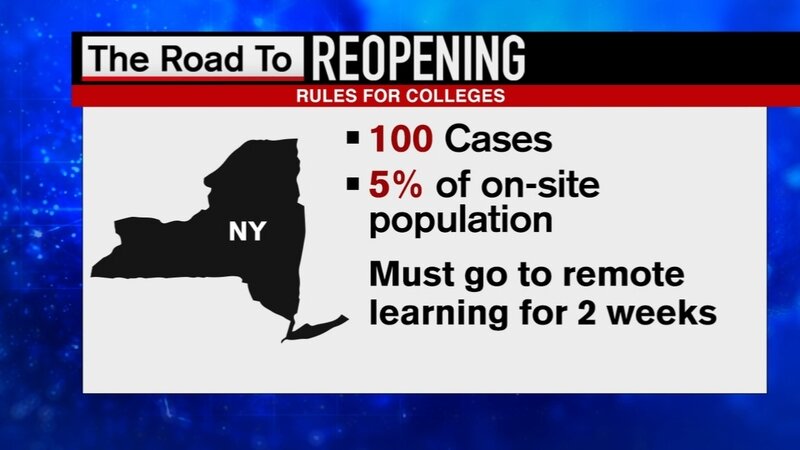New York Governor Andrew Cuomo updated his policy on the standards New York colleges and universities have to meet in order to remain open during the coronavirus pandemic. // Photo courtesy of ABC7NY
Hofstra University reported a cumulative total of 34 confirmed cases of COVID-19 from the beginning of August up until Tuesday, Sept. 8, according to an email sent to the Hofstra community from Student Affairs.
This announcement comes after New York state Governor Andrew Cuomo released a new set of guidelines on closing New York colleges and universities during the COVID-19 pandemic on Thursday, Aug. 27.
Cuomo lowered the threshold for the number of confirmed cases it takes for a college to shut down from 9% to 5% of a college’s student body or 100 cases – whichever is lower. If a school reaches this number of positive COVID-19 tests, the school must shift to remote learning for two weeks and reassess the situation to determine how to move forward.
In the meantime, all athletic activities and clubs will be suspended during the quarantine period and all dining hall options will need to be converted to take-out only, according to the parameters of Cuomo’s new guidelines.
Hofstra is working with Northwell Health to keep infection rates low enough to remain open for the entirety of the fall semester. “We have instituted a battery of facilities improvements and implemented a wide range of health and safety protocols,” said Provost and Senior Vice President for Academic Affairs Herman Berliner. “Together, [these] make us hopeful that Hofstra will be able to continue in-person instruction and remain open.”
Despite the University’s efforts to remain open and fully functioning, some students are concerned with what campus life would look should Hofstra reach 100 cases.
“How will we be able to get [access to] our normal amenities?” questioned sophomore drama major Elizabeth Tauro. She expressed concerns on how restrooms, dining facilities and other campus resources will run if the University were to undergo a two-week quarantine.
Other students are worried how a two-week quarantine would affect their daily lives. “There was zero human contact,” said sophomore dance major Jacob Kurihara, who quarantined for two weeks prior to moving in to his dorm. “I had not talked to, or even seen the face of another person … [I] would not by any means be the first in line to do it again.” During the mandatory quarantine, Kurihara said students were not allowed to leave their rooms at all.
If Hofstra has to move fully online for a period of time, Berliner said the University “would make decisions on issues related to campus and residence life after reviewing circumstances at the time.”
The possibility of a mandatory two-week shutdown has students whose classes are not suited for Zoom apprehensive about the future of their education.
“I [am] worried as to how capable I would be to participate in my dance classes with limited available space,” Kurihara said.
Limited space, however, is not the only concern students have when it comes to online classes.
“My biggest concern is money,” said Gavin Petersen, a sophomore drama major. “Why are we paying so much money to take online classes? It doesn’t make sense to me.” Petersen also questioned the quality of remote education.
Even though some students are worried about the prospect of Hofstra meeting Cuomo’s shutdown threshold, many others understand the importance of staying safe during this unprecedented time.
“[Cuomo’s plan is] a good idea because it’s keeping us safe, which is the most important thing,” Tauro said. “It won’t be the college experience we’re all looking for, but it is what it is.”
Although these new guidelines may seem daunting, Berliner is hopeful that the University’s new protocols will keep the rate of infection under Cuomo’s threshold of 100 cases in a two-week span.
“Be vigilant, be smart and be safe,” Berliner urged students. “It really is up to each of us to do the right thing so we can have a safe and successful semester.”







